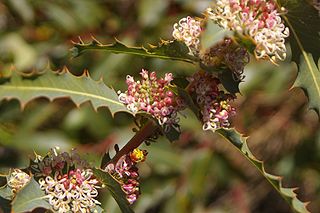
Hakea amplexicaulis, commonly known as prickly hakea, is a shrub endemic to south west Western Australia. An attractive small shrub with unusual stem clasping, sharply serrated foliage and a profusion of sweetly scented variable coloured flowers from late winter to spring.

Olearia phlogopappa commonly known as the dusty daisy-bush or alpine daisy-bush is a species of flowering plant in the family Asteraceae that is commonly found in eastern New South Wales, Victoria and Tasmania. It is a small shrub with greyish-green foliage, daisy-like flowers in white, pink or mauve that can be seen from spring to late summer.

Olearia floribunda, commonly known as heath daisy-bush, is a species of flowering plant in the family Asteraceae.

Olearia asterotricha, commonly known as rough daisy-bush, is a species of flowering plant in the family Asteraceae. A tall shrub with white, mauve or blue daisy like flowers growing from the Blue Mountains in New South Wales to western Victoria, Australia.
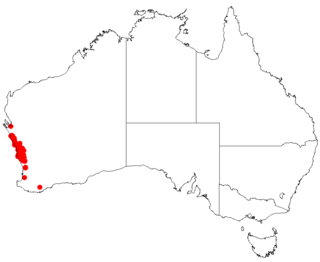
Hakea auriculata is a reasonably common shrub in the family Proteaceae endemic to Western Australia. A very showy species in full bloom with creamy white, yellow, dark red or reddish purple fragrant flowers.

Hakea circumalata is a shrub in the family Proteaceae native to an area in the Wheatbelt and Mid West regions of Western Australia. A small shrub producing a profusion of strongly scented pink to red flowers in dense clusters from July to September.

Hakea loranthifolia is a shrub of the family Proteaceae and is endemic to Western Australia. It has an open growth habit, stiff egg-shaped leaves with longitudinal veins, smooth grey bark and white flowers from July to September.

Hakea recurva, commonly known as jarnockmert, is a shrub or tree of the genus Hakea native to an area in the Mid West, northern Wheatbelt and the Goldfields-Esperance regions of Western Australia.
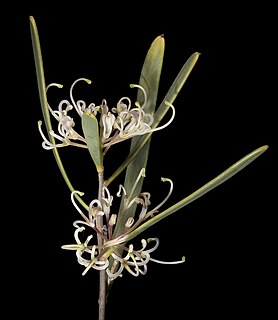
Hakea stenophylla is a shrub or tree in the family Proteacea, with sweetly scented creamy-white flowers. It is endemic to Western Australia.

Leionema dentatum, commonly known as toothed phebalium is a species of large shrub or small tree that is endemic to New South Wales, Australia. It has variable leaves, slender branches and clusters of cream-yellow flowers in spring.
Olearia adenolasia, commonly known as woolly-glandular daisy-bush, is a species of flowering plant in the family Asteraceae. It is a small upright shrub with sticky leaves and blue-purple or white daisy flowers.
Olearia aglossa, is a shrub in the family Asteraceae and is found in mountainous terrain in New South Wales and Victoria in Australia. It is a small shrub with spreading upright branches and white daisy-like flowers.
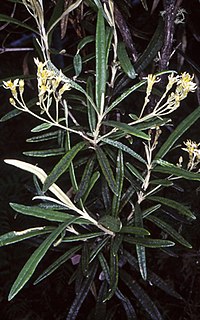
Olearia alpicola, commonly known as alpine daisy bush, is a shrub in the family Asteraceae and is found in mountainous terrain in New South Wales and Victoria in Australia. A small shrub with spreading branches and white daisy-like flowers.

Olearia brevipedunculata, commonly known as the dusty daisy-bush, is a small shrub with whitish-grey foliage and white daisy-like flowers in summer. Mostly found in Victoria and scattered locations in New South Wales, Australia.
Olearia cordata is an aromatic slender shrub with mostly mauve to dark blue daisy-like flowers endemic to New South Wales. Flowers appear in clusters at the end of branches, leaves are narrow and heart-shaped near the base.

Olearia magniflora, commonly known as the splendid daisy-bush, is a small shrub with clusters of deep mauve to purple flowers.

Olearia ciliata, commonly known as the fringed daisy bush, is a small shrub with large clusters of bright purple-blue flowers on a single stem.
Leionema equestre, commonly known as Kangaroo Island phebalium, is a shrub species that is endemic to South Australia. It is a small spreading shrub with rough, green leaves and whitish-pink flowers from late winter to October.
Leionema montanum, is a small shrub with terminal clusters of white-pink flowers in upper leaf axils in spring. It is endemic to Tasmania.
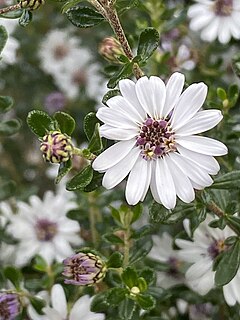
Olearia minor, is a small flowering shrub in the family Asteraceae. It has alternate leaves and white to pale mauve daisy-like flowers from winter to December. It grows in Western Australia, South Australia, New South Wales, and Victoria.














